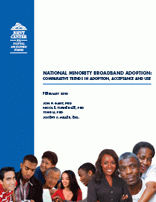Other Research on Broadband
Broadband Adoption and Use in America
A report released by John B. Horrigan, formerly of Pew Internet and now at the Federal Communications Commission, finds that 78% of adults in the U.S. are internet users and 65% of adults have home broadband access.
Adults who do not have broadband at home fall into four categories:
Digitally Distant: 10% of the general population. Median age is 63. Half say that the internet is not relevant to their lives or they lack the digital literacy to adopt broadband.
Digital Hopefuls: 8% of the general population. Low-income, heavily Hispanic and African American. Likely to say they want to go online, but lack the resources.
Digitally Uncomfortable: 7% of the general population. Likely to own a computer, but lack skills and interest in taking advantage of all the internet has to offer.
Near Converts: 10% of the general population. Median age is 45. Cost is the biggest barrier to having broadband at home.
These findings are in line with Pew Internet's previous work, including:
The FCC survey included interviews with 5,005 Americans in October-November 2009. Download the full report (HERE) at FCC.gov. You can find the full article here.
National Minority Broadband Adoption: Comparative Trends in Adoption, Acceptance, and Use

By Jon P. Gant, Ph.D., Nicol Turner-Lee, Ph.D., Ying Li, Ph.D., and Joseph S. Miller, Esq.
Between December 2009 and January 2010, the Joint Center for Political and Economic Studies conducted a study of 2,741 respondents, oversampling African Americans and Hispanics, to understand national minority broadband adoption trends, and examine broadband adoption and use between and within minority groups. This report addresses the experiences of minority consumers of wireline and mobile broadband services and provides insights into some of the factors affecting the decisions of minorities who have adopted broadband. You can dowload a copy of the report
here, or view the article online
here.
How companies are benefiting from Web 2.0: McKinsey Global Survey Results
The heaviest users of Web 2.0 applications are also enjoying benefits such as increased knowledge sharing and more effective marketing. These benefits often have a measurable effect on the business.
Over the past three years, we have tracked the rising adoption of Web 2.0 technologies, as well as the ways organizations are using them. This year, we sought to get a clear idea of whether companies are deriving measurable business benefits from their investments in the Web. Our findings indicate tha they are.
Dowload this report in .pdf here, or view the full article here.
Broadband and Local Growth
by Jed Kolko, Public Policy Institute of California | August 21, 2010
The economic benefits of broadband expansion for local residents appear to be limited. Broadband expansion is associated with population growth as well as employment growth, and both the average wage and the employment rate—the share of working- age adults that is employed—are unaffected by broadband expansion. Furthermore, expanding broadband availability does not change the prevalence of telecommuting or other home- based work. Like other place- based policies, expanding broadband availability could raise property values and the local tax base, but without more direct benefits for residents in the form of higher wages or improved access to jobs.
The analysis relies on the uneven diffusion of broadband throughout the United States, allowing comparisons between areas with greater and less growth in broadband availability. I combine broadband data from the Federal Communications Commission, employment data from the National Establishment Time- Series database, and other economic data from the U.S. Census and BLS to examine broadband availability and economic activity in the U.S. between 1999 and 2006.
Full Report
Technical Appendix